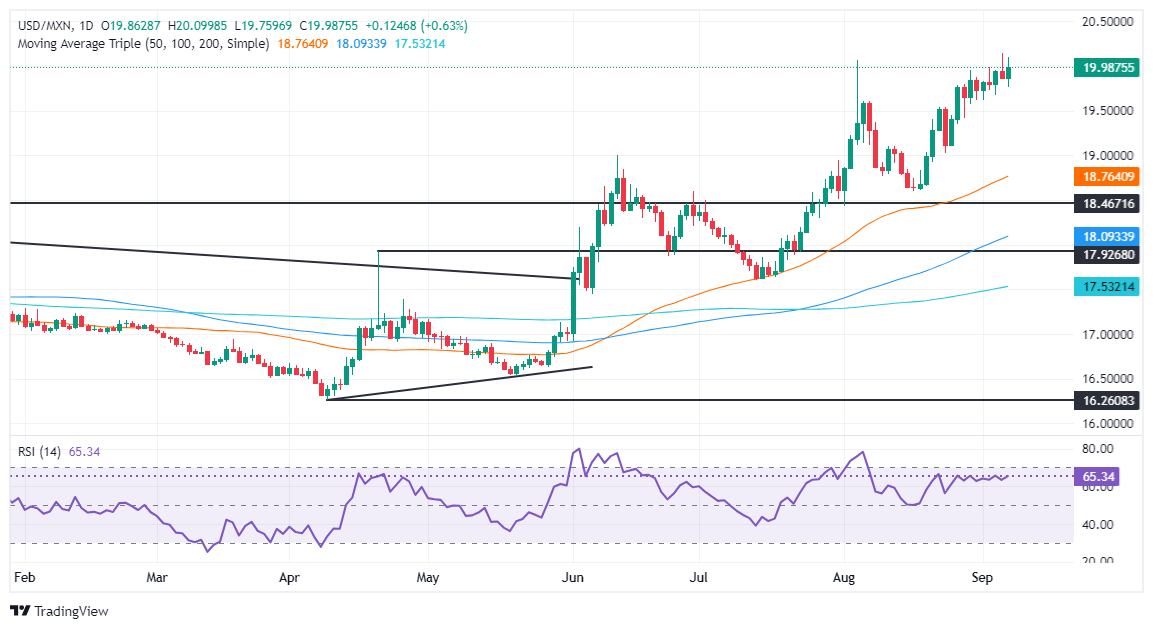Most recent article: Mexican Peso extends downtrend at a slower pace
- Mexican Peso tumbles as USD/MXN rallies above 20.00 following mixed US jobs data, hitting a daily high of 20.09 before retreating.
- Fed rate cut expectations remain uncertain, fluctuating between 50 and 25 bps, adding pressure on the Mexican Peso.
- Political instability in Mexico, driven by controversial judicial reforms, keeps traders risk-averse toward the Peso.
The Mexican Peso depreciated against the American currency on Friday after the US Nonfarm Payrolls (NFP) report spurred volatility in the bond market. Fed interest rate probabilities fluctuated between a 50 or 25-basis-point cut. This and Mexico’s political uncertainty around controversial reforms keep the Peso pressured. The USD/MXN trades at 20.00, gaining 0.73%.
The US Bureau of Labor Statistics (BLS) revealed that the US economy created fewer jobs than expected but improved compared to July figures. The same report showed that the Unemployment Rate, which ticked two-tenths higher in July, dipped in August, relieving the Federal Reserve (Fed) from lowering borrowing costs in an “aggressive” way.
After the data, the USD/MXN rallied above 20.00 and hit a daily peak of 20.09 but retreated as US yields retreated and undermined the Greenback.
As of writing, the US Dollar Index (DXY), which tracks the buck’s performance against another six currencies, has recovered and climbed 0.23%, up at 101.29, after hitting a low of 100.58.
Meanwhile in Mexico, the docket featured the release of the Citibanamex Expectations survey, Bank of Mexico Deputy Governor Jonathan Heath’s speech and Auto industry data. Politics will likely continue to drive USD/MXN price action for the remainder of September.
Additionally, political uncertainty weighed on the Mexican Peso as traders turned risk-averse to the carry trade involving that currency and bought the USD/MXN. Two days ago, the lower house sent a controversial package of bills to the Senate, including changes to the judicial system pushed by President Andres Manuel Lopez Obrador (AMLO).
If the Senate approves the judicial reform, then “it will be passed to 32 local congresses for their approval. Once the bill is approved in 17 of those states, the changes to the Mexican Constitution will be officially made,” writes FXStreet.
Daily digest market movers: Mexican Peso shrugs off soft US data, drops on risk aversion
- September’s Citibanamex Survey showed that private economists estimated the Mexican economy will grow 1.5% in 202$, down from 1.7%.
- Regarding inflation, the poll revealed that the Mexican Consumer Price Index (CPI) in 2024 would end at 4.60%, and next year it will hit 3.8%. Core CPI is forecast to end 2024 at 3.9%, and by 2025 it is expected to dive to 3.71%.
- The survey added that Banxico is expected to lower rates to 10.25% in 2024 and to 8.25% in 2025. The USD/MXN exchange rate is forecast to end 2024 at 19.50 and 2025 at 19.85.
- INEGI revealed that Mexico’s Auto Exports rose by 1.7% YoY in August after declining 2.7% YoY in July. Auto Production, meanwhile, rose by 8.3% YoY against the 2.7% of July.
- US Nonfarm Payrolls jumped by 142K in August but missed the mark of 160K. Should be said that July’s figures were downwardly revised from 114K to 89K.
- The Unemployment Rate dipped from 4.3% to 4.2%, while Average Hourly Earnings rose from 3.6% to 3.8% YoY in August.
- Data from the Chicago Board of Trade (CBOT) suggests the Fed will cut at least 104 basis points this year, up from 103 bps a day ago, according to the fed funds rate futures contract for December 2024.
Technical outlook: Mexican Peso softens as USD/MXN hovers around 20.00
Price action since the beginning of the rally in late May suggests that the USD/MXN uptrend is set to continue. Two times, buyers have bought the dip, and momentum is in their favor, as portrayed by the Relative Strength Index (RSI).
The RSI is bullish with an upward slope. Therefore, the path of least resistance is up.
If the USD/MXN clears 20.00, the next ceiling level would be the YTD high at 20.22. On further strength, the pair could challenge the daily high of September 28, 2022, at 20.57. If those two levels are surrendered, the next stop would be the swing high at 20.82 on August 2, 2022, ahead of 21.00.
Conversely, if USD/MXN weakens further, the first support would be 19.50. A breach of the latter will expose the August 23 swing low of 19.02 before giving way for sellers eyeing a test of the 50-day Simple Moving Average (SMA) at 18.65.
Mexican Peso FAQs
The Mexican Peso (MXN) is the most traded currency among its Latin American peers. Its value is broadly determined by the performance of the Mexican economy, the country’s central bank’s policy, the amount of foreign investment in the country and even the levels of remittances sent by Mexicans who live abroad, particularly in the United States. Geopolitical trends can also move MXN: for example, the process of nearshoring – or the decision by some firms to relocate manufacturing capacity and supply chains closer to their home countries – is also seen as a catalyst for the Mexican currency as the country is considered a key manufacturing hub in the American continent. Another catalyst for MXN is Oil prices as Mexico is a key exporter of the commodity.
The main objective of Mexico’s central bank, also known as Banxico, is to maintain inflation at low and stable levels (at or close to its target of 3%, the midpoint in a tolerance band of between 2% and 4%). To this end, the bank sets an appropriate level of interest rates. When inflation is too high, Banxico will attempt to tame it by raising interest rates, making it more expensive for households and businesses to borrow money, thus cooling demand and the overall economy. Higher interest rates are generally positive for the Mexican Peso (MXN) as they lead to higher yields, making the country a more attractive place for investors. On the contrary, lower interest rates tend to weaken MXN.
Macroeconomic data releases are key to assess the state of the economy and can have an impact on the Mexican Peso (MXN) valuation. A strong Mexican economy, based on high economic growth, low unemployment and high confidence is good for MXN. Not only does it attract more foreign investment but it may encourage the Bank of Mexico (Banxico) to increase interest rates, particularly if this strength comes together with elevated inflation. However, if economic data is weak, MXN is likely to depreciate.
As an emerging-market currency, the Mexican Peso (MXN) tends to strive during risk-on periods, or when investors perceive that broader market risks are low and thus are eager to engage with investments that carry a higher risk. Conversely, MXN tends to weaken at times of market turbulence or economic uncertainty as investors tend to sell higher-risk assets and flee to the more-stable safe havens.
Information on these pages contains forward-looking statements that involve risks and uncertainties. Markets and instruments profiled on this page are for informational purposes only and should not in any way come across as a recommendation to buy or sell in these assets. You should do your own thorough research before making any investment decisions. FXStreet does not in any way guarantee that this information is free from mistakes, errors, or material misstatements. It also does not guarantee that this information is of a timely nature. Investing in Open Markets involves a great deal of risk, including the loss of all or a portion of your investment, as well as emotional distress. All risks, losses and costs associated with investing, including total loss of principal, are your responsibility. The views and opinions expressed in this article are those of the authors and do not necessarily reflect the official policy or position of FXStreet nor its advertisers. The author will not be held responsible for information that is found at the end of links posted on this page.
If not otherwise explicitly mentioned in the body of the article, at the time of writing, the author has no position in any stock mentioned in this article and no business relationship with any company mentioned. The author has not received compensation for writing this article, other than from FXStreet.
FXStreet and the author do not provide personalized recommendations. The author makes no representations as to the accuracy, completeness, or suitability of this information. FXStreet and the author will not be liable for any errors, omissions or any losses, injuries or damages arising from this information and its display or use. Errors and omissions excepted.
The author and FXStreet are not registered investment advisors and nothing in this article is intended to be investment advice.
Note: This article have been indexed to our site. We do not claim legitimacy, ownership or copyright of any of the content above. To see the article at original source Click Here












